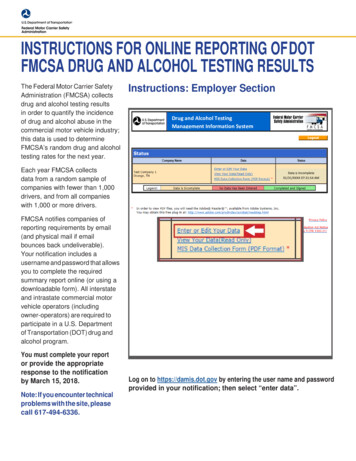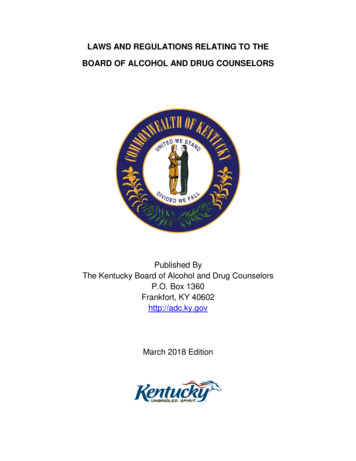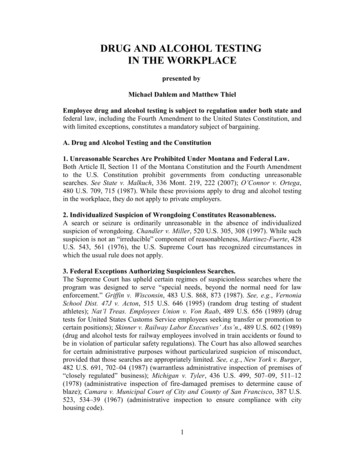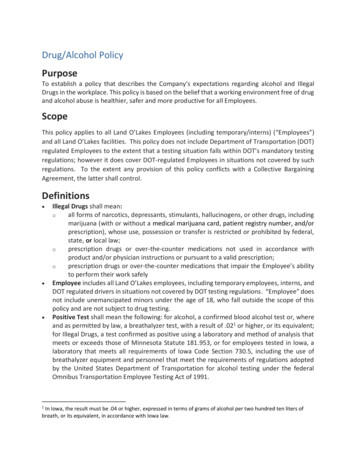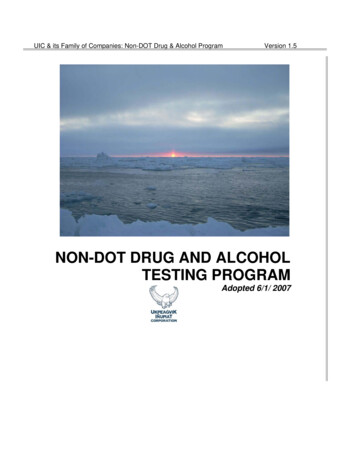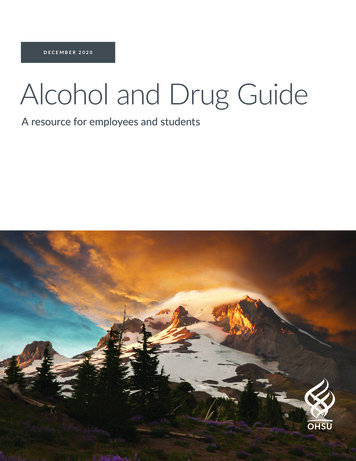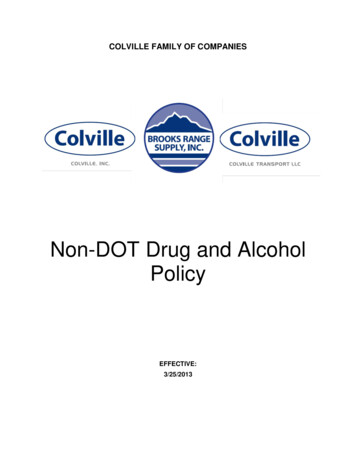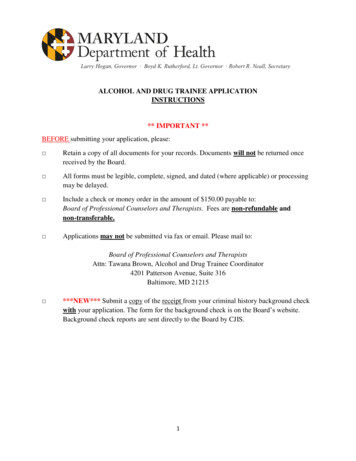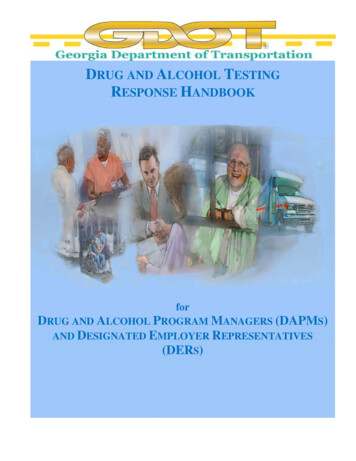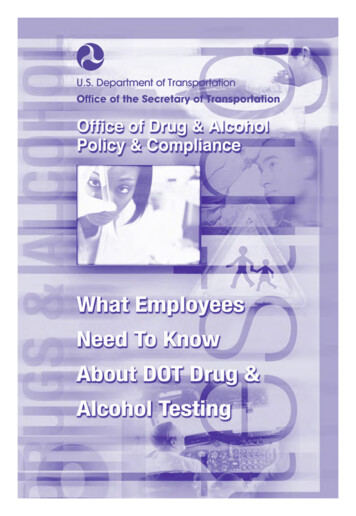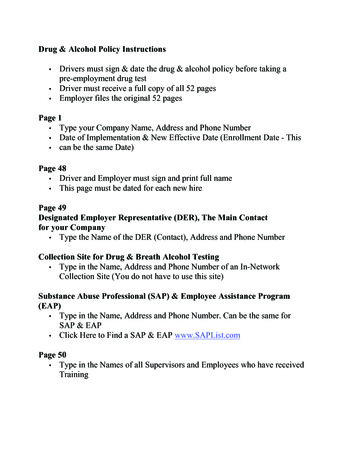
Transcription
Drug & Alcohol Policy Instructions Drivers must sign & date the drug & alcohol policy before taking apre-employment drug testDriver must receive a full copy of all 52 pagesEmployer files the original 52 pagesPage 1 Type your Company Name, Address and Phone Number Date of Implementation & New Effective Date (Enrollment Date - This can be the same Date)Page 48 Driver and Employer must sign and print full name This page must be dated for each new hirePage 49Designated Employer Representative (DER), The Main Contactfor your Company Type the Name of the DER (Contact), Address and Phone NumberCollection Site for Drug & Breath Alcohol Testing Type in the Name, Address and Phone Number of an In-NetworkCollection Site (You do not have to use this site)Substance Abuse Professional (SAP) & Employee Assistance Program(EAP) Type in the Name, Address and Phone Number. Can be the same forSAP & EAP Click Here to Find a SAP & EAP www.SAPList.comPage 50 Type in the Names of all Supervisors and Employees who have receivedTraining
DRUG AND ALCOHOL PLANU.S. DEPARTMENT OF TRANSPORTATIONFEDERAL MOTOR CARRIER SAFETY ADMINISTRATION (FMCSA)PREPARED IN ACCORDANCE WITH THE REQUIREMENTS OF:49 CFR PART 38249 CFR PART 40Type Company Name HereType Company Address HereType Company Phone Number HereORIGINAL DATE OF IMPLEMENTATION:NEW EFFECTIVE DATE:PLAN REVISION DATE: October 1, 2019Type Company Name Here
Table of t of “Combined” bilityCompliance“DOT” vs. “FMCSA”DOT ProceduresStand-down WaiverPreemption of State and Local LawsDefinitionsPOLICY AND RESPONSIBILITIES1.2.3.4.5.Company PolicyResponsibilities of Key PersonnelResponsibility of DriversUse of Service Agents“NON-DOT” Testing ProgramDOT PROGRAM REQUIREMENTS1.2.3.4.5.6.7.8.Drivers Subject to TestingAcknowledgement/Receipt FormHistory-check RequirementNotification of TestsDOT Drug ViolationsDOT Alcohol Violations and Prohibited ConductViolation Consequences and Company Actions.Drug and Alcohol TestsDRUG PROGRAM1.2.3.4.5.6.7.8.Drug Tests That Require Direct Observation ProceduresSpecimen Collection ProceduresDrug Testing LaboratoryLaboratory Retention Periods and ReportsMRO Review of Drug Test ResultsSplit Specimen TestingMedical MarijuanaSigns and Symptoms of Alcohol and Controlled Substances UseType Company Name 1222223
VI.VII.ALCOHOL PROGRAM1.Alcohol TestPROGRAM ELEMENTS COMMON TO DRUG AND ALCOHOL1.2.3.4.5.Substance Abuse ProfessionalEmployee Assistance ProgramSupervisor TrainingRecordkeepingManagement Information System4444454545464647VIII.APPENDIX AACKNOWLEDGEMENT/RECEIPT FORM48IX.APPENDIX BDESIGNATED PERSONNEL & SERVICE AGENTS49X.APPENDIX CSAFETY-SENSITIVE POSITIONS50XI.APPENDIX DCOMPANY DISCIPLINARY ACTIONS AND ADDITIONALPROCEDURES51XII.APPENDIX EPROCEDURES AND PLAN FOR IMPLEMENTATION OF THECOMMERCIAL DRIVER’S LICENSE DRUG AND ALCOHOLCLEARINGHOUSEType Company Name Here53
I. INTRODUCTION1. Development of “Combined” PlanThe Federal Motor Carrier Safety Administration (FMCSA) is the agency within the Department ofTransportation (DOT) that regulates motor carriers in the trucking industry. FMCSA's ControlledSubstances and Alcohol Use and Testing regulation, 49 CFR Part 3821, requires each motor carrier todevelop, maintain, and follow a Drug and Alcohol Policy (i.e., Plan). A basic requirement of the Plan isthat all drug and alcohol testing will follow the requirements of DOT's "Procedures for TransportationWorkplace Drug and Alcohol Testing," 49 CFR Part 402. The Drug and Alcohol Plan, henceforth referredto as the "Plan," meets all the requirements of Part 382 and Part 40.2. ApproachThe Plan will use the generic word “Company” in reference to the motor carrier for which it is written. ThePlan will describe how the Company will comply with government requirements.The Plan will identify “Company-additional” requirements - those that go beyond the minimumrequirements of DOT. Company-additional requirements will be underscored. Therefore, consideranything that is not underscored a requirement of DOT, or a process put in place by the Company tomeet a DOT requirement. Appendix D outlines the Company disciplinary actions and additionalprocedures.The Plan is written in “plain language” and follows the requirements of each rule. However, the Plandoes not repeat the language of either Part 40 or Part 382. Doing so would require the Company toproduce a new plan every time DOT or FMCSA issued a change to their respective rule. The goal ofDOT is to know that the Company understands the requirements of the rules and how the Company willgo about achieving compliance. The Plan makes use of existing DOT language in places wheresummaries are used to explain a more detailed process (e.g., specimen collection and alcohol testprocedures are extracted from DOT's “Employee Guide”3).3. BackgroundSafety. The DOT requires transportation employers to develop and implement drug and alcohol testingprograms in the interest of public safety. Safety is the highest priority for DOT. One of the means bywhich the DOT helps ensure safety is by subjecting those drivers responsible for transportation safety todrug and alcohol testing. Drivers tested under the DOT program have direct impact on the safety of thetraveling public.Test Procedures. The overall responsibility for management and coordination of the DOT programresides within the Office of the Secretary of Transportation's (OST), Office of Drug and Alcohol Policyand Compliance (ODAPC). ODAPC issues Part 40. Whether the transportation employee is a pipelineworker, truck driver, or airline pilot, their drug and alcohol tests are conducted using the same Part 40procedures. This consistency benefits all employees affected by DOT regulations in that each agency'sregulations must adhere to DOT's testing procedures. Better known simply as “Part 40,” this rule hasbecome the standard for workplace testing in the United States.1Title 49 Code of Federal Regulations (CFR), Part 382, “Controlled Substances and Alcohol Use and Testing,”Federal Motor Carrier Safety Administration, Department of Transportation, 61 FR 9553, Mar. 8, 1996 as amended.2Title 49, Code of Federal Regulations (CFR), Part 40, “Procedures for Transportation Workplace Drug andAlcohol Testing Programs,” Office of the Secretary, Department of Transportation, 65 FR 79462, Dec. 19, 2000 asamended.3“What Employees Need To Know About DOT Drug & Alcohol Testing,” ODAPC, DOT, October, 2010.Type Company Name HereFMCSA DRUG/ALCOHOL PLAN1
Compliance Enforcement. Regulation and enforcement within the different transportation industriesis the responsibility of the DOT agency (e.g., FMCSA for trucking) that has authority over the particularindustry. The regulatory authority requiring drug and alcohol testing of safety-sensitive employees inaviation, trucking, railroads, and mass transit industries is the Omnibus Transportation EmployeeTesting Act of 19914 (OTETA).II. GENERAL1. ApplicabilityPart 382, and this Plan, applies to every person and to all employers of such persons who operate acommercial motor vehicle in commerce in any State, and is subject to: (1) The commercial driver's5license requirements of Part 383 ; (2) The Licencia Federal de Conductor (Mexico) requirements; or(3) The commercial drivers license requirements of the Canadian National Safety Code.2. CompliancePlan Development. The Plan meets the requirement of Part 382, paragraph §382.601, to provideeducational materials that explain the requirements of Parts 382 and 40 and the Company's policies andprocedures with respect to meeting these requirements. The Plan describes the methods andprocedures for compliance with the drug and alcohol program requirements of the DOT. The Plan coversthe operational, day-to-day requirements that are found in Part 382, and the procedural, testingrequirements that are found in Part 40. The Plan provides appendices for the name and address of eachlaboratory that analyzes specimens for the Company, the Company's Medical Review Officer, SubstanceAbuse Professionals, and Employee Assistance Professionals. The Plan communicates to drivers,Company officials, and DOT officials the path that the Company will follow in order to comply with therequirements for a successful DOT drug and alcohol program.Plan Availability. The Plan will be posted in a common place, selected by the Company, for driverreview and feedback. A copy of the Plan will be made available to all drivers. Any driver desiring a copyof Part 40 and/or Part 382 must contact the Designated Employer Representative (see Appendix B). ThePlan will provide a basic description of the rules and testing requirements, and will show how theCompany implements and follows them. The Plan is not meant as a substitute for the detail provided ineither rule. If there is any difference in instruction or interpretation between the Plan and the rules, therules prevail. The Plan will be updated at any time its language, or the intent of its language, differs fromthat of either Part 40 or Part 382. Drivers are encouraged to obtain and read Part 40 and Part 382 ontheir own.3. “DOT” vs. “FMCSA”All DOT workplace testing procedures will follow Part 40 requirements. All DOT proceduralresponsibilities for motor carriers will follow Part 382. In the Plan, the term “DOT” will be used forreferences to general requirements (e.g., testing procedures) placed on motor carriers. The use of theterm “FMCSA” will be to distinguish specific, unique administration requirements versus general, DOTrequirements (e.g., blood alcohol test results received from law enforcement may be used in a postaccident situation).4Public Law 102-143, October 28, 1991, Title V - Omnibus Transportation Employee Testing, 105 Stat. 952-965;49 U.S.C. 45104(2).5Title 49 Code of Federal Regulations (CFR), Part 383, “Commercial Drivers License Standards; Requirement andPenalties,” Federal Motor Carrier Safety Administration, 52 FR 20587, June 1, 1987, as amended.Type Company Name HereFMCSA DRUG/ALCOHOL PLAN2
4. DOT ProceduresThe Company will assure that the procedures of Part 40 are followed for drug and alcohol testingconducted under the requirements and authority of Part 382; a violation of Part 40 is a violation of Part382. If the Company employs a Consortium/Third-Party Administrator (C/TPA) to assist in programdevelopment, implementation, and management, the C/TPA will, likewise, follow all the requirements ofPart 40 and Part 382. It is the Company's goal to establish and maintain compliance with the DOT drugand alcohol program.5. Stand-down WaiverDOT “stand-down” is not in effect for this Company. The Company does not hold a stand-down waiverunder Part 40, and has not applied for one. Should this status change, the Company will notify all driversand Company officials, in accordance with Part 40 requirements.6. Preemption of State and Local LawsPart 40 and Part 382 are Federal laws. Federal law preempts any state or local law, rule, regulation, ororder to the extent that: (a) compliance with both the state or local requirement and Part 40 or 382 is notpossible; or, (b) compliance with the state or local requirement is an obstacle to the accomplishment andexecution of any requirement of Part 40 or 382. This provision does not preempt provisions of statecriminal law that impose sanctions for reckless conduct leading to actual loss of life, injury, or damageto property, whether the provisions apply specifically to transportation employees or employers or to thegeneral public.7. DefinitionsDefinitions from Parts 40, and 382 have been combined in alphabetical order and are provided in a singlelisting. For purposes of the Plan the following definitions apply:Actual knowledge - For the purpose of Part 382 (subpart B) and the Plan, means actual knowledge byan employer that a driver has used alcohol or controlled substances based on the employer's directobservation of the employee, information provided by the driver's previous employer(s), a traffic citationfor driving a CMV while under the influence of alcohol or controlled substances or an employee'sadmission of alcohol or controlled substance use, except as provided in Sec. 382.121. Direct observationas used in this definition means observation of alcohol or controlled substances use and does not includeobservation of employee behavior or physical characteristics sufficient to warrant reasonable suspiciontesting under Sec. 382.307.Administrator - The Administrator of the Federal Motor Carrier Safety Administration (FMCSA) or anyperson to whom authority in the matter concerned has been delegated by the Secretary ofTransportation.Adulterated specimen - A specimen that has been altered, as evidenced by test results showing eithera substance that is not a normal constituent for that type of specimen or showing an abnormalconcentration of an endogenous substance.Affiliate - Persons are affiliates of one another if, directly or indirectly, one controls or has the power tocontrol the other or a third party controls or has the power to control both. Indicators of control include,but are not limited to: interlocking management or ownership; shared interest among family members;shared facilities or equipment; or common use of employees. Following the issuance of a Public InterestExclusion (PIE), an organization having the same or similar management, ownership, or principalemployees as the service agent concerning who public interest exclusion is in effect is regarded as anaffiliate. This definition is used in connection with the public interest exclusion procedures of Part 40,Subpart R.Air blank - In evidential breath testing devices (EBTs) using gas chromatography technology, a readingof the device's internal standard. In all other EBTs, a reading of ambient air containing no alcohol.Type Company Name HereFMCSA DRUG/ALCOHOL PLAN3
Alcohol - The intoxicating agent in beverage alcohol, ethyl alcohol or other low molecular weightalcohols, including methyl or isopropyl alcohol.Alcohol concentration - The alcohol in a volume of breath expressed in terms of grams of alcohol per210 liters of breath as indicated by a breath test under this part.Alcohol confirmation test - A subsequent test using an EBT, following a screening test with a result of0.02 or greater, that provides quantitative data about the alcohol concentration.Alcohol screening device (ASD) - A breath or saliva device, other than an EBT, that is approved bythe National Highway Traffic Safety Administration (NHTSA) and placed on a conforming products list(CPL) for such devices.Alcohol screening test - An analytic procedure to determine whether an employee may have aprohibited concentration of alcohol in a breath or saliva specimen.Alcohol testing site - A place selected by the employer where employees present themselves for thepurpose of providing breath or saliva for an alcohol test.Alcohol use - The drinking or swallowing of any beverage, liquid mixture or preparation (including anymedication), containing alcohol.Aliquot - A fractional part of a specimen used for testing. It is taken as a sample representing the wholespecimen.Breath Alcohol Technician (BAT) - A person who instructs and assists employees in the alcohol testingprocess and operates an evidential breath testing device.Cancelled test - A drug or alcohol test that has a problem identified that cannot be or has not beencorrected, or which Part 40 otherwise requires to be cancelled. A cancelled test is neither a positive nora negative test.Chain-of-custody (or Custody and Control Form (CCF)) - The procedure used to document thehandling of the urine specimen from the time the employee gives the specimen to the collector until thespecimen is destroyed. This procedure uses the Federal Drug Testing Custody and Control Form(CCF).Collection Container - A container into which the employee urinates to provide the specimen for a drugtest.Collection Site - A place selected by the employer where employees present themselves for thepurpose of providing a urine specimen for a drug test.Collector - A person who instructs and assists employees at a collection site, who receives and makesan initial inspection of the specimen provided by those employees, and who initiates and completes theCCF.Commerce - (1) Any trade, traffic or transportation within the jurisdiction of the United States between aplace in a State and a place outside of such State, including a place outside of the United States; and(2) Trade, traffic, and transportation in the United States which affects any trade, traffic, andtransportation described in paragraph (1) of this definition.Commercial Motor Vehicle (CMV) - A motor vehicle or combination of motor vehicles used in commerceto transport passengers or property if the vehicle-- (1) Has a gross combination weight rating of 11,794or more kilograms (26,001 or more pounds) inclusive of a towed unit with a gross vehicle weight ratingof more than 4,536 kilograms (10,000 pounds); or (2) Has a gross vehicle weight rating of 11,794 ormore kilograms (26,001 or more pounds); or (3) Is designed to transport 16 or morepassengers, including the driver; or (4) Is of any size and is used in the transportation of materialsfound to be hazardous for the purposes of the Hazardous Materials Transportation Act (49 U.S.C. 5103(b)) and which require the motor vehicle to be placarded under the Hazardous MaterialsType Company Name HereFMCSA DRUG/ALCOHOL PLAN4
Regulations (49 CFR part 172, subpart F).Confirmatory drug test - A second analytical procedure performed on a different aliquot of the originalspecimen to identify and quantify the presence of a specific drug or drug metabolite.Confirmation (or confirmatory) validity test - A second test performed on a different aliquot of theoriginal urine specimen to further support a validity test result.Confirmed drug test - A confirmation test result received by a MRO from a laboratory.Consortium/Third-Party Administrator (C/TPA) - A service agent that provides or coordinates theprovision of a variety of drug and alcohol testing services to employers. C/TPAs typically performadministrative tasks concerning the operation of the employers' drug and alcohol testing programs. Thisterm includes, but is not limited to, groups of employers who join together to administer, as a single entity,the DOT drug and alcohol testing programs of its members. C/TPAs are not “employers” for purposes ofPart 40.Continuing education - Training for substance abuse professionals (SAPs) who have completedqualification training and are performing SAP functions, designed to keep SAPs current on changes anddevelopments in the DOT drug and alcohol testing program.Controlled substances - Those substances identified in Part 40 and this plan as “drugs.”DOT Procedures (or Part 40) - The Procedures for Transportation Workplace Drug and Alcohol TestingProgram published by the Office of the Secretary of Transportation in 49 CFR Part 40.Designated employer representative (DER) - An employee authorized by the employer to takeimmediate action(s) to remove employees from safety-sensitive duties, or cause employees to beremoved from these safety-sensitive duties, and to make required decisions in the testing and evaluationprocesses. The DER also receives test results and other communications for the employer, consistentwith the requirements of Part 40. Service agents cannot act as DERs.Dilute specimen - A urine specimen with creatinine and specific gravity values that are lower thanexpected for human urine.Disabling damage - Damage which precludes departure of a motor vehicle from the scene of theaccident in its usual manner in daylight after simple repairs. (1) Inclusions. Damage to motor vehiclesthat could have been driven, but would have been further damaged if so driven. (2) Exclusions. (i)Damage which can be remedied temporarily at the scene of the accident without special tools or parts.(ii) Tire disablement without other damage even if no spare tire is available. (iii) Headlight or taillightdamage. (iv) Damage to turn signals, horn, or windshield wipers which make them inoperative.DOT, The Department, DOT agency - These terms encompass all DOT agencies, including, but notlimited to, the Federal Aviation Administration (FAA), the Federal Railroad Administration (FRA), theFederal Motor Carrier Safety Administration (FMCSA), the Federal Transit Administration (FTA), theNational Highway Traffic Safety Administration (NHTSA), the Pipeline and Hazardous Materials SafetyAdministration (PHMSA), and the Office of the Secretary (OST). These terms include any designee of aDOT agency.Driver - Any person who operates a commercial motor vehicle. This includes, but is not limited to: Fulltime, regularly employed drivers; casual, intermittent or occasional drivers; leased drivers andindependent owner-operator contractors.Drugs - The drugs for which tests are required under Part 40 and DOT agency regulations aremarijuana, cocaine, amphetamines, phencyclidine (PCP), and opioids.Employee (safety-sensitive employee) - Any person who is designated in a DOT agency regulation assubject to drug testing and/or alcohol testing. The term includes individuals currently performing safetysensitive functions designated in DOT agency regulations and applicants for employment subject to preemployment testing. For purposes of drug testing under Part 40, the term employee has the samemeaning as the term "donor" as found on CCF and related guidance materials produced by theDepartment of Health and Human Services. For the purposes of regulation under Part 382, theterm employee means a person (i.e., driver) who performs a safety-sensitive function, including fulltime, part-time and temporary employees.Employer - A person or entity employing one or more employees (including an individual who is selfemployed) subject to DOT agency regulations requiring compliance with Part 40. The term includes anType Company Name HereFMCSA DRUG/ALCOHOL PLAN5
employer's officers, representatives, and management personnel. Service agents are not employers forthe purposes of Part 40.Error Correction Training - Training provided to BATs, collectors, and screening test technicians(STTs) following an error that resulted in the cancellation of a drug or alcohol test. Error correctiontraining must be provided in person or by a means that provides real-time observation and interactionbetween the instructor and trainee.Evidential Breath Testing Device (EBT) - A device approved by NHTSA for the evidential testing ofbreath at the .02 and .04 alcohol concentrations, placed on NHTSA's Conforming Products List (CPL)for “Evidential Breath Measurement Devices” and identified on the CPL as conforming with the modelspecifications available from NHTSA's Traffic Safety Program.HHS, Department of Health and Human Services - The Department of Health and Human Servicesor any designee of the Secretary, Department of Health and Human Services.Initial drug test (also known as a “Screening drug test”) - The test used to differentiate a negativespecimen from one that requires further testing for drugs or drug metabolites.Initial specimen validity test - The first test used to determine if a urine specimen is adulterated,diluted, substituted, or invalid.Invalid drug test - The result reported by a HHS-certified laboratory in accordance with the criteriaestablished by HHS Mandatory Guidelines when a positive, negative, adulterated, or substituted resultcannot be established for a specific drug or specimen validity test.Laboratory - Any U.S. laboratory certified by HHS under the National Laboratory Certification Programas meeting the minimum standards of Subpart C of the HHS Mandatory Guidelines for FederalWorkplace Drug Testing Programs; or, in the case of foreign laboratories, a laboratory approved forparticipation by DOT under this part.Licensed medical practitioner - A person who is licensed, certified, and/or registered, in accordancewith applicable Federal, State, local, or foreign laws and regulations, to prescribe controlled substancesand other drugs.Limit of Detection (LOD) - The lowest concentration at which a measurand can be identified, but (forquantitative assays) the concentration cannot be accurately calculated.Limit of Quantitation - For quantitative assays, the lowest concentration at which the identity andconcentration of the measurand can be accurately established.Medical Review Officer (MRO) - A person who is a licensed physician and who is responsible forreceiving and reviewing laboratory results generated by an employer's drug testing program andevaluating medical explanations for certain drug test results.Negative result -The result reported by a HHS-certified laboratory to a MRO when a specimen containsno drug or the concentration of the drug is less than the cutoff concentration for the drug or drug classand the specimen is a valid specimen.Non-negative specimen - A urine specimen that is reported as adulterated, substituted, positive (fordrug(s) or drug metabolite(s)), and/or invalid.Office of Drug and Alcohol Policy and Compliance (ODAPC) - The office in the Office of theSecretary, DOT, that is responsible for coordinating drug and alcohol testing program matters within theDepartment and providing information concerning the implementation of Part 40.Type Company Name HereFMCSA DRUG/ALCOHOL PLAN6
Oxidizing adulterant - A substance that acts alone or in combination with other substances to oxidizedrugs or drug metabolites to prevent the detection of the drug or drug metabolites, or affects the reagentsin either the initial or confirmatory drug test.Performing (a safety-sensitive function) - A driver is considered to be performing a safety-sensitivefunction during any period in which he or she is actually performing, ready to perform, or immediatelyavailable to perform any safety-sensitive functions.Positive rate for random drug testing - The number of verified positive results for random drug testsconducted under Part 382, plus the number of refusals of random drug tests required by Part 382, dividedby the total number of random drug tests results (i.e., positives, negatives, refusals) conducted underPart 382.Positive result - The result reported by a HHS-certified laboratory when a specimen contains a drug ordrug metabolite equal to or greater than the cutoff concentrations.Primary specimen - In drug testing, the urine specimen bottle that is opened and tested by a firstlaboratory to determine whether the employee has a drug or drug metabolite in his or her system; andfor the purpose of validity testing. The primary specimen is distinguished from the split specimen, definedin this section.Prohibited drug - Any of the following substances specified in Schedule I or Schedule II of theControlled Substances Act (21 U.S.C. 812): marijuana, cocaine, opioids, amphetamines,and phencyclidine (PCP).Qualification Training - The training required in order for a collector, BAT, MRO, SAP, or STT to bequalified to perform their functions in the DOT drug and alcohol testing program. Qualification trainingmay be provided by any appropriate means (e.g., classroom instruction, internet application, CD-ROM,video).Reconfirmed - The result reported for a split specimen when the second laboratory is able to corroboratethe original result reported for the primary specimen.Rejected for testing - The result reported by a HHS-certified laboratory when no tests are performedfor a specimen because of a fatal flaw or a correctable flaw that is not corrected.Refresher Training - The training required periodically for qualified collectors, BATs, and STTs to reviewbasic requirements and provide instruction concerning changes in technology (e.g., new testing methodsthat may be authorized) and amendments, interpretations, guidance, and issues concerning Part 40 andDOT agency drug and alcohol testing regulations (e.g., Part 382). Refresher training can be provided byany appropriate means (e.g., classroom instruction, internet application, CD-ROM, video).Refusal to submit, refuse, or refuse to take - Behavior consistent with Part 40 concerning refusal totake a drug test or refusal to take an alcohol test.Safety-sensitive function - All time from the time a driver begins to work or is required to be in readinessto work until the time he/she is relieved from work and all responsibility for performing work. Safetysensitive functions shall include: (1) All time at an employer or shipper plant, terminal, facility, or otherproperty, or on any public property, waiting to be dispatched, unless the driver has been relieved fromduty by the employer; (2) All time inspecting equipment as required by Sections 392.7 and 392.8 orotherwise inspecting, servicing, or conditioning any commercial motor vehicle at any time; (3) All timespent at the driving controls of a commercial motor vehicle in operation; (4) All time, other than drivingtime, in or upon any commercial motor vehicle except time spent resting in a sleeper berth (a berthconforming to the requirements of Section 393.76); (5) All time loading or unloading a vehicle,supervising, or assisting in the loading or unloading, attending a vehicle being loaded or unloaded,remaining in readiness to operate the vehicle, or in giving or receiving receipts for shipments loaded orunloaded; and (6) All time repairing, obtaining assistance, or remaining in attendance upon a disabledvehicle.Screening drug test - See Initial drug test definition above.Type Company Name HereFMCSA DRUG/ALCOHOL PLAN7
STT) - A person who instructs and assists employees in the alcohol testing process and operates anASD.Secretary - The Secretary of Transportation or the Secretary's designee.Service agent - Any person or entity, other than an employee of the employer, who provides
Drug & Alcohol Policy Instructions Drivers must sign & date the drug & alcohol policy before taking a pre-employment drug test Driver must receive a full copy of all 52 pages Employer files the original 52 pages Page 1 Type your Company Name, Address and Phone Number Date of Implementation & New Effective Date (Enrollment Date - This can be the same Date)
